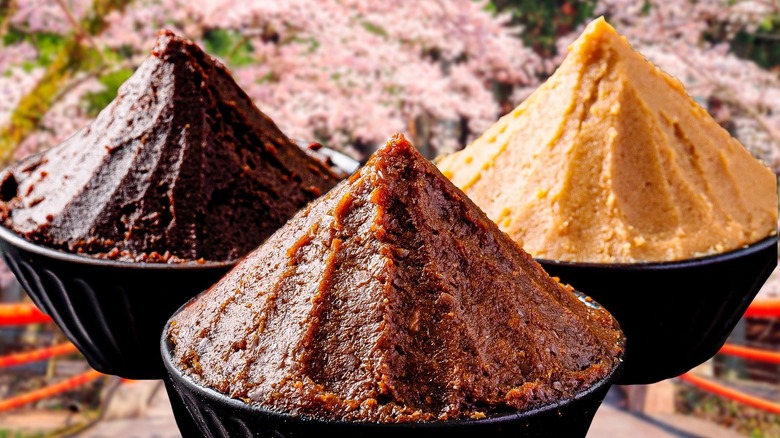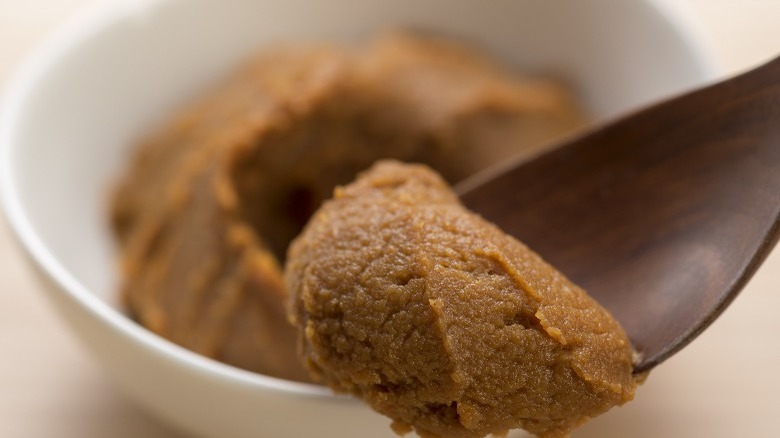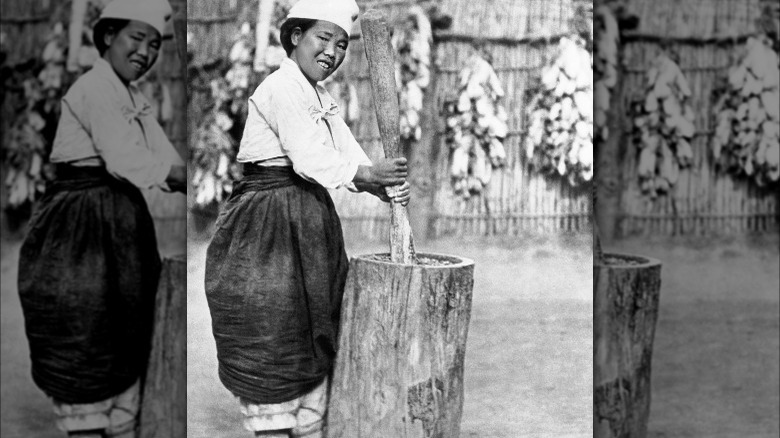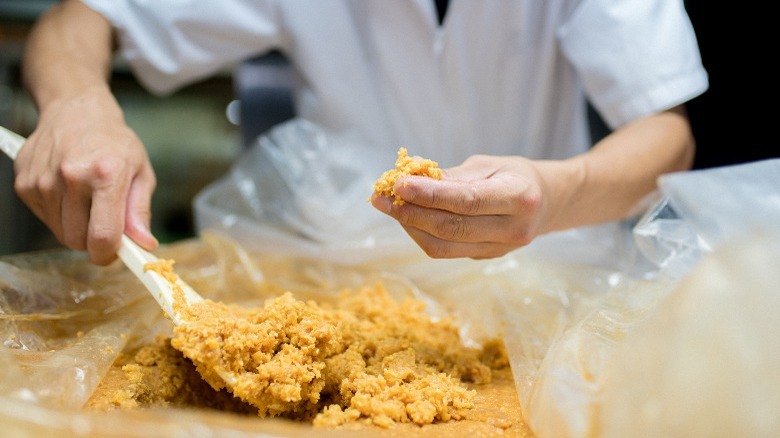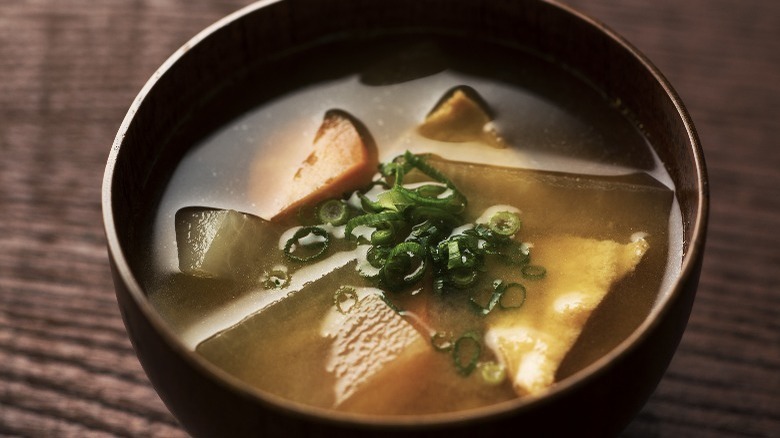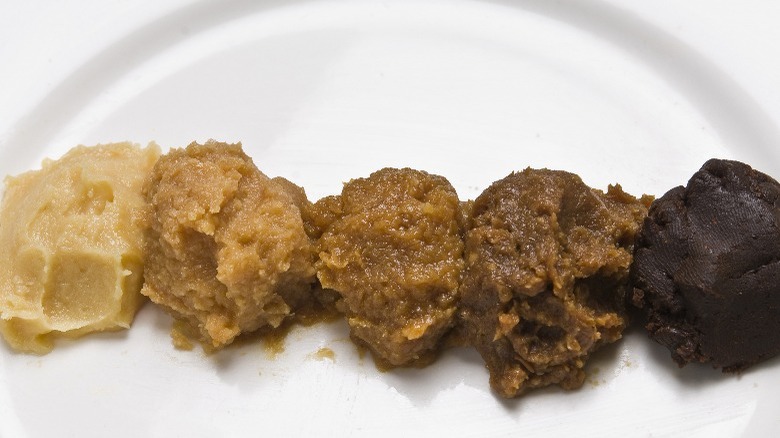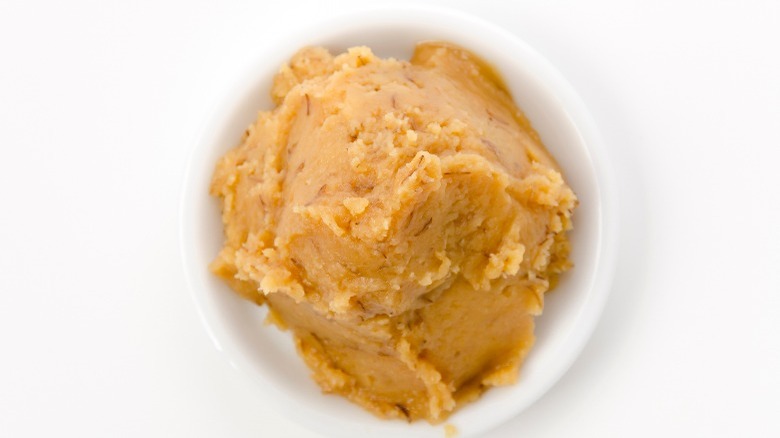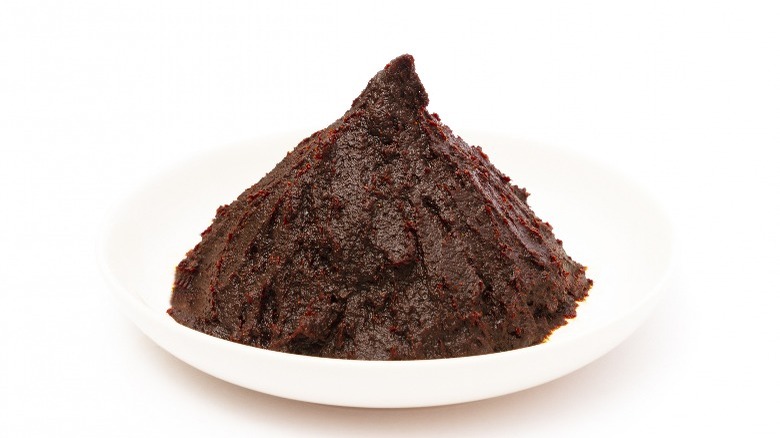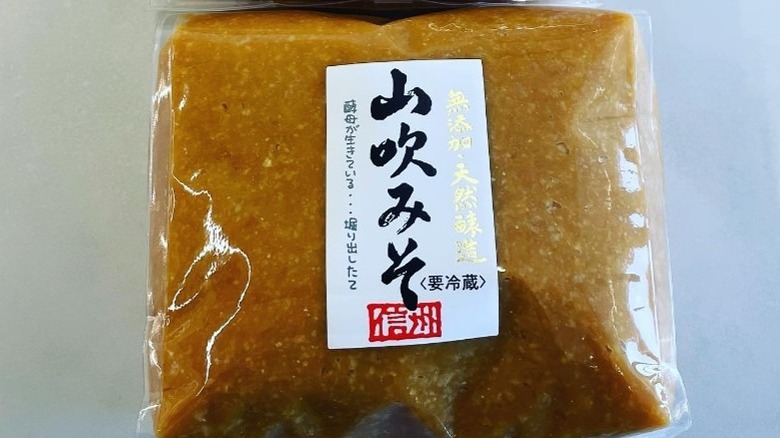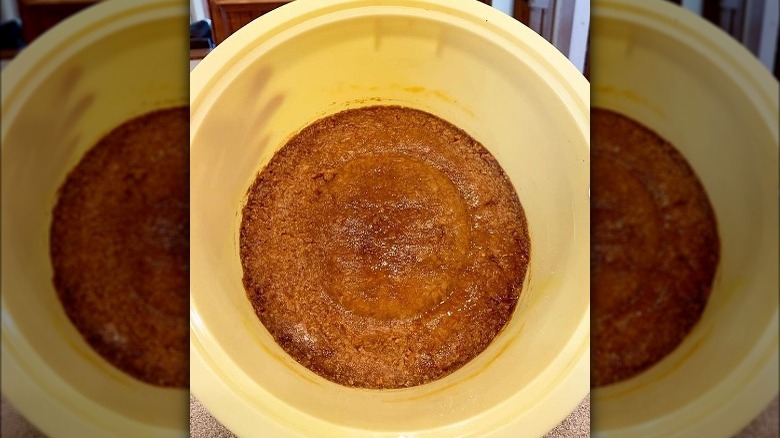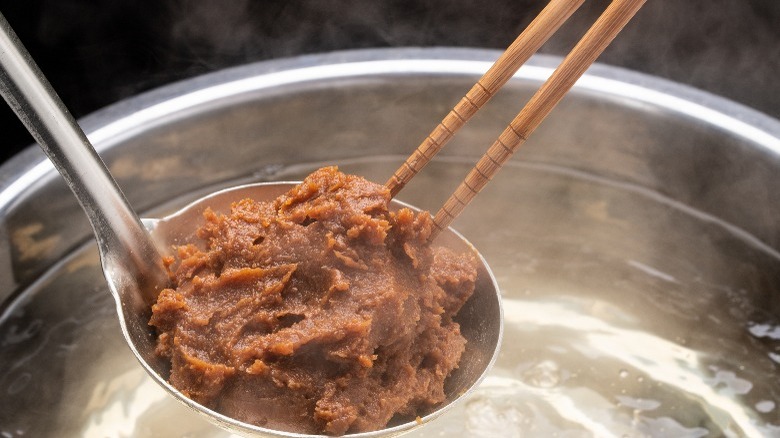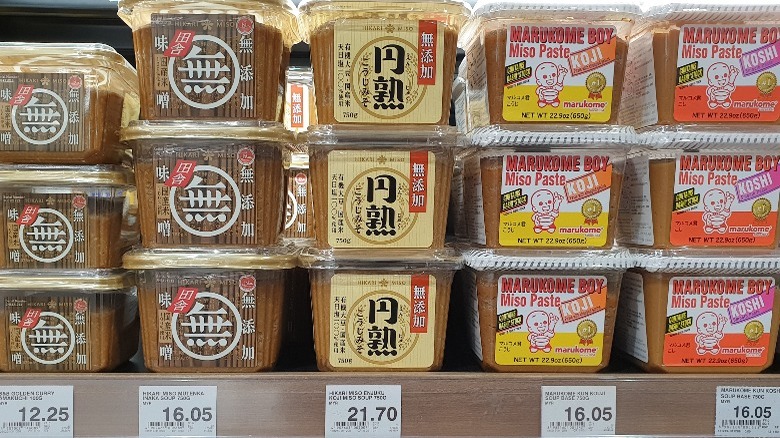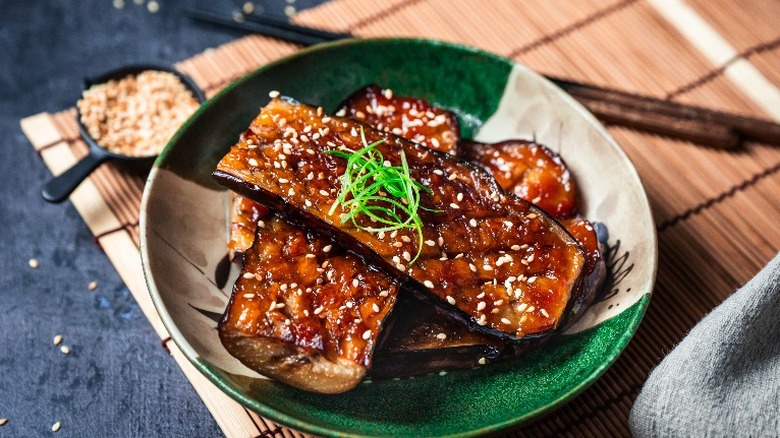The Ultimate Guide To Miso
If you've ever seen tubs of miso in your local store and wondered exactly what it is, where it comes from, and how it's made, this is the guide for you. As well as taking you through all these things, we'll explain how to choose between the many different types of miso you'll find out there, how to store your miso, and what to make with it.
You'll be surprised at the sheer variety of sweet and savory dishes you can whip up with miso. A few include miso soup, pork, crispy Brussels sprouts with roasted apples, butter pudding, turkey meatballs and scallion yakitori, miso-based ice cream, ancient grain bowls, and the list goes on. With our ultimate guide, you'll go from miso newbie to seasoned miso expert in next to no time.
This delicious, versatile ingredient deserves a place in everyone's fridge, whether you stock up on red miso, white miso, or one of the many other types available. Discover everything you ever needed — and wanted — to know about miso.
What is miso?
Miso is a fermented soybean paste that adds umami flavor, the fifth taste, to food. This versatile ingredient is extremely popular in Japan, and there are four main different types of miso: barley miso, rice miso, soybean miso, and blended miso.
Rice miso is by far the most popular miso produced in Japan, and despite their differing names, all miso pastes contain soybeans. Miso can be used to make soup, sauces, dressings, marinades, as a condiment, and even as an ingredient in desserts.
Miso can also be categorized by color, so you'll often hear people speaking about red miso, white miso, and so on. Generally speaking, the lighter the miso, the more versatile it is in cooking. White miso is also an excellent introduction to the world of miso, as it's less salty and lighter in flavor than darker miso, like red miso, which has been fermented for longer.
A brief history of miso
Miso has been around in Japan for over 1,300 years, though the savory soybean paste actually originated in ancient China. The first mention of miso was during the Heian period when it was a luxury item reserved only for wealthy elites.
In due time, miso began to be used in miso soup by Buddhist monks arriving in Japan from China during the Kamakura period. Later, during the Muromachi period, farmers in Japan began producing their own miso, with people from all walks of life using the paste to add rich, savory umami flavor to their cooking.
Miso was once taken into battle by Sengoku samurai warriors, as the paste was easy to preserve, packed with protein, and a quick way to add flavor to food. During the Edo period, when demand for miso outstripped local production, miso began to be imported from the countryside as more miso shops opened in what is now known as Tokyo.
How miso is made
All miso production starts with koji, aspergillus oryzae, a fungus used in many Japanese fermented foods such as miso, sake, and soy sauce that helps develop complex flavors. Koji mold is added to steamed soybeans, rice, or barley to be cultured in a humid, warm environment.
The koji turns starch into sugar, releasing amino acids such as glutamic acid, which provides an umami flavor. Then, cultured koji is added to barley, rice, or soybeans and left to ferment to create miso.
Miso's complex flavor is a blend of sweetness, saltiness, and umami, all affected by the fermentation process. The more rice koji content in the miso, the sweeter the paste. Miso that undergoes a longer aging process will be less sweet.
The umami flavors of miso will also increase with aging, as glutamic acid forms when soybean protein breaks down during the aging process. Strangely, though the salt content of miso doesn't change during maturation, we perceive miso that's aged longer as less salty, a phenomenon that is known as shio-nare, where the umami and sour flavors influence our taste buds.
Miso's nutritional benefits
Miso is considered a superfood, packed with probiotics to support your digestive system, and can reduce symptoms linked to digestive issues such as IBS, according to Healthline. Because it's a fermented food, it's good news for gut health and is also packed with zinc, copper, and magnesium.
An excellent source of omega-3 fatty acids, B vitamins, and vitamin K, miso may promote heart health and help reduce cholesterol levels. Studies posted on PubMed also show that consuming this savory soybean paste regularly may reduce the risk of breast and liver cancer by up to 54%.
It's important to consume miso in moderation, as it's very high in salt. However, unlike some other salty foods that can increase the risk of stomach cancer, miso hasn't been linked to an increased risk, according to another study posted on PubMed.
The microorganisms and probiotics in miso are destroyed when cooking at high heat. This is why it's a good idea to add miso to your recipe towards the end of the cooking time, and always try to purchase unpasteurized miso to reap the most health benefits.
The different types of miso
If you've ever shopped for miso, chances are you'll have felt overwhelmed by the various different types on store shelves. Generally speaking, there are four main types of miso: rice miso, barley miso, soybean miso, and blended miso.
To confuse matters further, there are different colors of miso. In the U.S., miso is often categorized by color, with white miso, yellow miso, red miso, and blended miso all commonly available.
In Japan, miso is more commonly categorized according to the main ingredient, so you'll often see it labeled as kome miso for white rice, mugi miso for barley, and so on. This is why shopping for and choosing the right miso can be a confusing experience depending on where in the world you are and what dishes you'd like to make with your miso.
Below, we'll dive into the different types and colors of miso in more detail to help you choose the right type of miso for your cooking. It's a good idea to have a couple of different types to hand, as each can be used in very different ways, as you'll see.
White miso
White miso is the lightest color of all the misos. You'll also hear it called shiro miso or sweet miso. White miso uses a higher concentration of koji, creating a sweeter flavor. Fewer soybeans are added to white miso than red, with a ratio of around 60% rice/barley and 40% soybeans. Shiro miso also undergoes a shorter period of fermentation than red miso, usually around one to two weeks.
This mild, light miso is a great introduction for newcomers. An incredibly versatile miso thanks to its lighter flavor, it's excellent for making miso soup, delicious added to salad dressings or marinades, and a solid choice for miso aubergine or miso salmon. You can even add it to desserts, using it to make salted caramel sauce or miso ice cream or in place of dairy.
You'll find specialist varieties of white miso from different regions of Japan, such as Saikyo miso, a low-sodium, mild white miso produced in Kyoto. White miso is sold in most stores, though it's often cheaper to buy it at Asian or specialist grocery stores or even on Amazon. Look for miso without any added alcohol or preservatives, as then you can be sure you're buying the best natural miso.
Red miso
Red miso is also known as aka miso, and it is a much darker color than white miso, ranging from a deep rusty red to burgundy or even black. The dark color is caused by a longer fermentation time and a process called the Maillard reaction, where soybean amino acids react with sugars, resulting in deep color and intense, salty flavors that are very different from white miso.
Where white miso is light, sweet, and mild, red miso's flavor is much more pungent. The deeper the color of red miso, the more complex the flavor, and you'll find specialist red misos from different parts of Japan, such as sendai miso, a deep dark red-brown miso from Miyagi prefecture. Aka miso is best used in heartier dishes such as hotpots, stews, and rich marinades, though its depth of flavor may not be to everyone's tastes, particularly those new to the world of miso.
It's a good idea to keep both red and white miso in your fridge so that you always have the right type to hand. You can use each in different ways or combine the two for even more versatility in your cooking.
Yellow miso
Yellow miso, or shinshu miso, is the middle ground between white and red miso. Ranging in color from light yellow to light brown, it's fermented for longer than white miso but not as long as red miso and is saltier than shiro miso, with more barley and soybeans in the mixture.
Compared to red miso, shinshu miso has a more acidic flavor profile and tastes less salty too. This makes it an excellent multipurpose miso for use in marinades, soups, and more. If you prefer saltier miso to shiro miso, this is a great, versatile miso to get, as you'll find you can use it in a wider range of dishes than red miso. You're more likely to find red and white miso in general grocery stores, so you may need to make a trip to a specialist Asian grocery store for yellow miso or order it online.
Mixed miso
Mixed miso, known in Japan as awase or chogo miso, is a blend of red and white miso. Combining the sweet, mild flavors of white miso with the salty, rich tastes of red miso makes mixed miso one of the most versatile misos out there and explains its incredible popularity in Japanese cooking.
In order for miso to be designated as mixed, it must use two or more types of koji or two more types of soybean, barley, or rice miso. Unsure what type of miso to buy at your local store? Mixed miso is a good all-rounder as you can use it for a variety of different dishes, and it packs flavor elements from both white and red miso.
As well as various different colors of miso, you'll also find miso is made with a range of different ingredients. Don't worry, we'll also dive into each of those ingredients in more detail.
Miso's different ingredients
In Japan, miso is usually categorized according to its main ingredient, and as we mentioned earlier, there are several different main ingredients in miso. We'll take you through some brief details of each different type of miso and what ingredients they contain. Kome miso or rice miso is made with soybeans, salt, and rice koji. This type of miso is the most popular miso in Japan, and it comes in a range of colors.
Mame miso, also known as soybean miso, is made from soybeans, salt, and soybean koji. Fermented for between one to three years, it is deeply savory, with rich umami flavors and high acidity. Mame miso is usually a black-brown color, and one of Japan's most popular types of mame miso is hatcho miso, from Okazaki.
Mugi miso or barley miso is fermented for up to three years and uses a blend of salt, soybeans, and barley koji. Its color can range from white to dark brown, while its flavor is rich, salty, and sweet, with a pungent malty aroma from the barley.
Then you'll find genmai miso and soba miso. Genmai miso, or brown rice miso, is fermented for at least 12 months. Despite its name, this red miso is known for its deeply nutty flavor. Rarer than other types of miso, soba miso has a similar flavor to soba noodles, with buckwheat added during the fermentation process.
How to choose the right miso for cooking
Choosing the right miso for whatever you're cooking depends on a few different factors. First, think about whether you prefer mild, sweet flavors like white miso, a rich, pungent, intense taste such as red miso, or a combination of the two from yellow miso.
Then, consider the type of dish you're making. If you're marinating fish or making a salad dressing, a delicate, sweet miso like white miso is your best choice. For heartier soups, stews, meat glazes, or any slow-cooked dishes, red miso's deep umami flavor and salt content is a better match. For desserts, white miso's sweet flavor profile is delicious in salted caramel sauce or ice cream.
Whichever type of miso you choose, it's best to add it towards the end of your cooking time, if you can. Heating miso over a high heat kills the probiotics and reduces many of this superfood's health benefits.
How to shop for miso
At first glance, the range of miso on store shelves can feel a bit overwhelming. Don't worry — there are a few things to consider that can help you when shopping for miso.
Look out for some of the most popular brands that are renowned for their excellent, high-quality miso, like Hikari, Miko, or Namikura, most of which are readily available on Amazon. Cheaper brands may include additives, alcohol, or sweeteners which can impact shelf life and may use a faster fermentation process that results in a less complex flavor.
Speaking of additives, always read the ingredients list when shopping for miso. Look for brands where the ingredients are simply soybeans, water, and a type of grain. You'll also sometimes see salt, seaweed, or koji listed too. The very best miso product isn't a completely smooth paste but naturally has a more granular consistency to it.
How long does miso last and how should it be stored?
So you've chosen the right type of miso for your recipe and picked it up at your local store — what now? Good news: miso has a surprisingly long shelf life and will keep for ages in your fridge.
Lighter miso, such as shiro miso, can be stored in your fridge for up to nine months. Darker miso, like red miso, will keep for about a year, sometimes even longer. With that said, it's a good idea to keep an eye on your miso and check it before using it. There shouldn't be any mold or oxidation that looks like surface darkening on your miso.
Oxidation isn't harmful, but it can affect miso's flavor. You can easily prevent it by storing your tub of miso with a little parchment paper or plastic wrap pressed over the surface. Don't forget to check the use-by date of your miso too, both in-store before purchasing and after the paste has spent a few months in your fridge.
What can you make with miso?
Wondering what to make with your miso? The possibilities are limited only by your imagination. The first step for those new to miso is to give miso soup a try. This classic Japanese soup is a simple recipe made with miso paste, dashi, green onions, and tofu. The miso is added at the end of the cooking time to preserve its probiotics.
Miso is also an excellent addition to salad dressings. Try making a delicious miso-tahini dressing with tahini, garlic, lemon juice and zest, and fresh parsley to add umami to your greens, or liven up summer salads with a miso vinaigrette – you can make that simple dressing with some white miso, sambal olek, sugar, salt, and rice wine vinegar.
Perhaps one of the most unusual ways to use miso is in desserts. Sweet white miso can be added to salted caramel sauce for depth of flavor, included in a chocolate bread or butter pudding for a salty twist, or even used to make moreish sweet and salty miso ice cream. And, of course, if you're looking for a more everyday recipe, you can it as a marinade for chicken or to make miso-glazed salmon.
